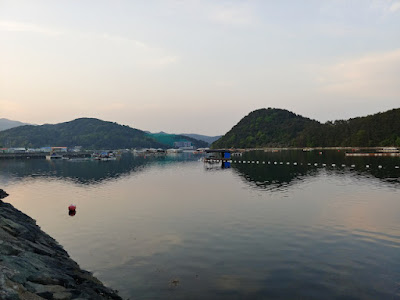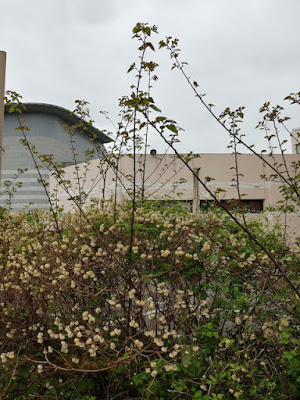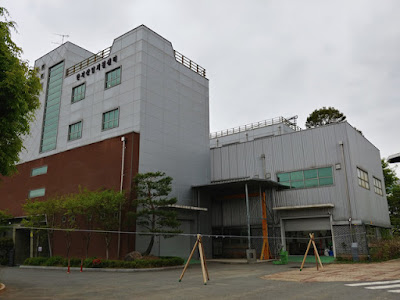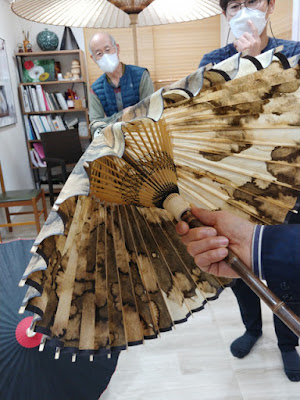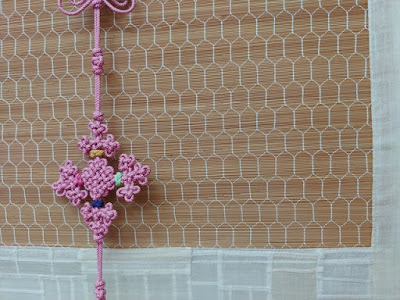I feel like I've already showed this lovely central rotary at school in Jeonju. I took an afternoon break and the assistant came along so that we could enjoy the good weather. She talked about how it was never this nice before they spent the money to fancy up the rotary. The water will come up in magnificent fountain style at points in the day that I assume are scheduled, and the entire pool is tiled with a map of the world if you go up into the structure to look down.
From the for rent sign, this was clearly a bad idea from the start, in the neighborhood adjacent to the university.
Rather than take a bus (direct buses don't run often from Jeonju to Jinju) tomorrow, I left town early on Friday with Dr. Jo, who came to install his entries for the 27th National Hanji Crafts Contest.
I was confused about the whole thing but it seems like the actual work will be juried and then shown during a
hanji culture festival at the
Korean Traditional Culture Center. You can tell where my brain has turned off when it comes to certain aspects of hanji promotion.
Dr. Jo's junior colleague (I don't have a good translation for this, but usually like an alum from your school who is younger than you) Dr. Kim came by to help. I was getting stickler-y about it but eventually Dr. Jo waved it off and said it's good enough to be evaluated by. His background is in forest science so the approach is different (all the hanji he uses is made by
Mr. Shin).
There are two different sections of the jurying, one is for traditional hanji crafts and one is for contemporary. Dr. Jo also is submitting his hanji leather bags on the latter side.
A few people already dropped off their work for consideration and here are two jido (like papier-mâché) hand lanterns.
I related SO much to this process, twisting paper into thread on your thigh!! Hanji doll making is very big but I never got into that.
We saw the woman who made this come in to set it up, she came all the way from Mokpo and I loved that she used bark lace that still has green bark left on it as the floor mats in this diorama while the clothes are made from bleached white bark lace.
She came with another woman who was helping her set up a hot glue gun and I saw that one of them had a handsewn cloth purse made of patchwork hexagons.
On our way to lunch I noticed plants that looked exactly like mitsumata, and that was true, because we were passing the Hanji Industry Support Center. Here on the other side is not only the mitsumata but dak (the taller shoots).
For some reason they were doing dochim outside even though it was about to rain. The clothespins are all split bamboo.
Eventually they wrapped the dochim machine and took all the paper in.
I think I've been twice to this hanji industry support center, and things have changed a lot from the outside. The area around it is slightly more developed I think, but it's so hard to remember as there seems to be much more going on than the first time.
The second time was with a group and we were wildly exhausted from being bussed all over the place so I don't remember the outside or much of the inside besides being in a classroom being lectured to about something related to hanji.
This section of the maker space in the craft center made me feel crazy because I didn't bring my tape measure with me (usually it's on my keychain for my house but I left my keys behind). I have to get a new one soon because taking pictures of things next to my hand is not really the best way to measure things. Not the worst, but not the best.
After visiting with In Mi-ae at KTCC, we each left with a lovely gift of a box of face masks containing hanji, which came just in time as I am running low on my KF94 masks. Glad to be restocked for another month! Our last stop in Jeonju was to see the provincial intangible treasure holder of paper umbrella making,
Yoon Gyu-sang and his son. This is a photo of them in the studio. Since we all keep our masks on, I have no idea what anyone looks like unless we share meals together.
We sat underneath a giant paper umbrella, which was the perfect setting.
It's hanji made with tons of tough or unbeaten fibers left in, and I kept wondering where the seams were. They're on the outside of the ribs, not on this side.
Tons and tons of bamboo ribs for different sizes of umbrellas. Mr. Yoon is the only holder of this property in Korea, which makes me sad because they are so lovely and I wish more people made them. Of course like all of these other intangible properties, I know
why so few do it, but still.
His son could tell that I wanted to see more than listen, so he pulled out umbrellas to show me. The red and black are basic colored hanji, the blue also colored but seemingly made with either poor formation or intentionally mottled formation, and then the lighter one is plain hanji that was oiled after the umbrella was made. If you oil beforehand, you can't glue the paper to the ribs and then you have a problem.
Here is a post in Korean but with nice pics of Mr. Yoon at work.
That's why Dr. Jo was visiting: he had met Mr. Yoon years ago before he was designated as a treasure holder, and wanted to learn to make the umbrellas. After being refused, he asked if he could provide the hanji for Mr. Yoon to use to make umbrellas, to which the latter agreed. This is Dr. Jo's dyed, joomchi-ed, and oiled hanji turned into an umbrella. But the top had popped off, so he was bringing it for repairs. Mr. Yoon's son remembered how hard it was to glue this umbrella because the paper was oiled, so there's a possibility that the entire paper covering has to be replaced.

Then we were finally off to return to Jinju. The plan was for me to spend the weekend in the guest house preparing for today's lecture for Dr. Lee's colleagues. The weather has been lovely and after too many hours in coffee shops with my computer, I did walk around a bit. This construction was not the exciting part, but the fact that even when laying asphalt, they sometimes use twig brooms! I couldn't get a good shot but the guy whose back is to us in the orange vest has one of them.
I walked by this at first and then went back to shoot it and share with a UMich grad, who said this is hilarious because they are using the UMich school colors with Michigan State's name. Meaningless to Koreans here but I wonder if anyone back home would get in trouble wearing this.
Because the guest house is so close to the Jinju Fortress (I don't know about this translation, it doesn't feel that way but obviously things have changed a lot. The area is walled and in Korean it's called Jinjuseong), I went to visit again. It happened to be during Hanbok Culture week for the whole country, so they set up a fashion show of hanbok that had to be shot and then shared on YouTube because of pandemic.
It was very windy but they had set everything up for shooting, with all of those massive arms with cameras whipping around.
I was too far to get good pics but there was a mix of bystanders, staff, and models watching or getting ready to be filmed.
You can see how much distance is between each model!
I decided to leave out of a side gate and look for dinner at the department store. I had tried to get food at one place where the granny told me to go someplace else if I wanted to eat a particular dish, as she only made it for two people. Dept stores are great for safe solo dining, and I treated myself to very expensive Hallabong afterwards (extremely delicious citrus, bigger than mandarins and sweeter, zero seeds).
On the way out I could see the tarps weighted in one part of the city next to the river.
Construction had started in this area years back but when too many ancient artifacts turned up, they had to stop immediately and plan instead for proper excavation.
This is dinner from yesterday, and funny enough I was thinking about my cousin as we had this meal in Seoul when I first emerged from quarantine (samgyetang, boiled stuffed chicken). Then he called me afterwards! Hoping I get to see him next time I make it back north.
I did not think getting my lecture together would take so long, but Keynote was freaking out so I had to bite the bullet and do an OS upgrade that I was hoping to avoid until I got back home. That took a while, and after things seemed to stabilize, I took my computer to this lovely tea house. I wanted to sit near the windows but that group of five folks was a bit too close for comfort in pandemic times so I stayed in the back.

Omija tea, exactly what I needed after a big dinner, though extremely itself (the sourness, whew!). I was also rebuilding a new lecture because my older versions for some reason were all damaged. And when talking to Koreans about hanji in the US, it's a totally different story than talking to Americans about hanji in Korea (or the US). I can plow through hundreds of slides pretty quickly in English because I talk so fast, but it's going to be more of a challenge in Korean. I'm looking forward to sharing regardless, and the process of combing thru old pics to see if there are were better ones was an excellent exercise to see how much and what I've managed to do, the people I've met along the way, and how hardships and fallings out don't negate all the work.
After that, off to Tongyeong!



